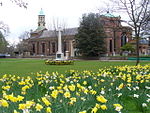Palm House, Kew Gardens

The Palm House is a large palm house in the Royal Botanic Gardens, Kew, in London, that specialises in growing palms and other tropical and subtropical plants. It was completed in 1848. Many of its plants are endangered or extinct in the wild. Features include an upper walkway, taking the visitor into the branches of the larger plants. Kew also has the even larger "Temperate House", kept at lower temperatures. Initially built as status symbols in Victorian Britain, several examples of ornate glass and iron greenhouses, often but not always called "the Palm House", can still be found in botanical gardens and parks such as Liverpool's Sefton Park and Stanley Park, and in other countries. The Palm House was the first greenhouse to be built on this scale. It was also the first large-scale structural use of wrought iron.
Excerpt from the Wikipedia article Palm House, Kew Gardens (License: CC BY-SA 3.0, Authors, Images).Palm House, Kew Gardens
Thames Path - northern Bank, London Isleworth (London Borough of Hounslow)
Geographical coordinates (GPS) Address Website Nearby Places Show on map
Geographical coordinates (GPS)
| Latitude | Longitude |
|---|---|
| N 51.479166666667 ° | E -0.29277777777778 ° |
Address
Royal Botanic Gardens, Kew
Thames Path - northern Bank
TW8 8HE London, Isleworth (London Borough of Hounslow)
England, United Kingdom
Open on Google Maps










